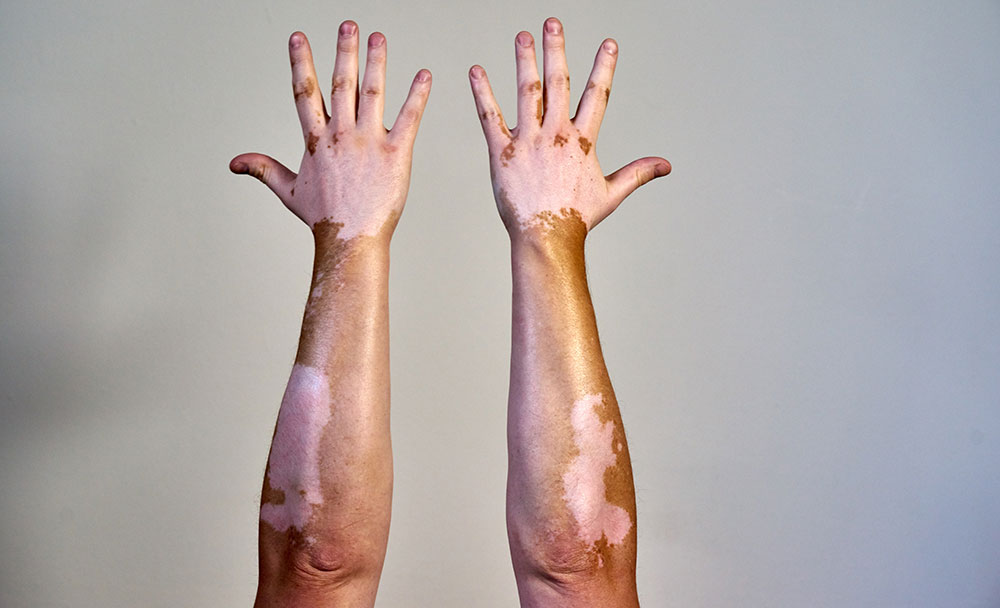Vitiligo
Vitiligo: Understanding the Types, Signs, Causes, and Treatment Options in Connecticut
Vitiligo is a skin condition that causes areas of skin to lose pigment, resulting in lighter or white patches. While not painful or contagious, vitiligo can have a profound emotional impact—especially when it affects visible areas like the face, hands, or arms.
At Dermatology Physicians of Connecticut, we understand how deeply skin conditions like vitiligo can affect your quality of life. Our board-certified dermatologists are experienced in diagnosing and treating vitiligo with compassionate care and the latest therapeutic options.
If you’ve noticed white patches on your skin or want to better understand vitiligo signs and treatment options, this guide will walk you through what to know.
What Is Vitiligo?
Vitiligo is a chronic autoimmune skin disorder where the body's immune system attacks melanocytes—the skin cells responsible for producing pigment (melanin). This leads to the formation of white or depigmented patches that may appear anywhere on the body.
Vitiligo affects about 1% of the population and can begin at any age, although it often develops before age 30.

Common Signs of Vitiligo
The primary sign is loss of skin color in patches, which may begin on sun-exposed areas like the:
-
Face
-
Hands
-
Arms
-
Feet
-
Around the eyes, mouth, and nose
Other signs can include:
-
Premature graying of scalp, eyebrows, eyelashes, or beard
-
Color loss inside the mouth or nose
-
Changes in eye color (less common)
These signs can vary in progression and location—some people experience rapid spreading, while others may have stable, localized patches for years. Read more about common signs of Vitiligo.
Types of Vitiligo
Vitiligo is classified into two main types: nonsegmental vitiligo and segmental vitiligo.
- Nonsegmental Vitiligo (NSV) is the most common type. It usually appears symmetrically on both sides of the body and often affects areas prone to friction or trauma—like the face, hands, feet, upper chest, groin, and around body openings (mouth, eyes, genitals). Patterns include:
- Generalized: widespread involvement
- Acrofacial: face and extremities
- Focal: limited to one or a few areas
- Universal: nearly the entire body
- Mucosal: involves lips or genitals
- Segmental Vitiligo (SV) tends to appear on only one side or section of the body and typically develops earlier in life. It usually stabilizes after the first year and may not respond as well to medical therapies but can be considered for surgical options.
Some people may have a combination of both types. Understanding the type of vitiligo is key to determining the most effective treatment.
What Causes Vitiligo?
While the exact cause remains unclear, several factors are believed to contribute:
- Autoimmune Response – The immune system attacks pigment-producing cells.
- Genetics – Vitiligo can run in families.
- Oxidative Stress – An imbalance of free radicals in the skin.
- Skin Trauma or Sunburn – May trigger new patches.
- Endocrine Disorders – Conditions like hypothyroidism or diabetes can be associated.
If you’ve noticed new or worsening areas of discoloration—especially after sun exposure—it’s a good idea to consult a dermatologist.
Vitiligo Treatment Options in Connecticut
There is no cure for vitiligo, but many treatment options can help restore pigment, even out skin tone, or slow progression. Our dermatologists tailor treatments to your unique needs and skin type:
-
Topical Medications
- Corticosteroids: Can help restore pigment in early-stage vitiligo
- Calcineurin Inhibitors (e.g., tacrolimus): Especially useful for sensitive areas like the face
-
Light Therapy (Phototherapy)
- Narrowband UVB: The gold standard for widespread vitiligo
- Typically administered in-office, a few times per week
-
Excimer Laser Therapy
- Targets small, localized patches
- Effective on areas like the hands and face
-
Micropigmentation (Medical Tattooing)
- Used to camouflage stable vitiligo, especially around the lips or eyes
-
Depigmentation Therapy
- In patients with extensive vitiligo, lightening the remaining pigmented skin may help create a uniform appearance
-
Skin Grafting
- A surgical option for stable vitiligo, where healthy skin is transplanted to affected areas
Treatment choice depends on multiple factors, including skin tone, the location and extent of patches, and personal preferences.
Living With and Managing Vitiligo
Vitiligo is often unpredictable, but daily care can help reduce its visibility and manage symptoms:
- Use Broad-Spectrum Sunscreen (SPF 30+) Daily: UV rays can worsen pigment loss, especially during sunny Connecticut summers.
- Consider Makeup or Self-Tanners: These can help blend depigmented areas for a more even appearance.
- Stay Supported: Emotional support is important. Consider connecting with local or online vitiligo support groups.
We also offer cosmetic consultations to explore safe camouflage and makeup options.
When to See a Dermatologist
If you're developing new white patches or have a personal or family history of autoimmune conditions, early dermatologic evaluation is key. Prompt diagnosis allows for earlier intervention and more effective treatment planning.
At Dermatology Physicians of Connecticut, our board-certified team provides comprehensive vitiligo care and ongoing support. Whether you live in Fairfield County, New Haven, or beyond, we’re here to help.
Schedule an Appointment Today
Vitiligo can be managed—and we’re here to help you feel more confident in your skin. Schedule an in-person visit or a secure telehealth appointment through our Klara messaging system.
📍 Serving Norwalk, Shelton, Branford, Hamden, and surrounding areas.

